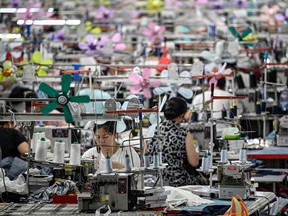Politicians’ promises are aimed at this key voter base, but the challenges have changed
Article content
During a federal election campaign, you’re likely to see the vying political parties make promises and policy proposals to a key (but rather nebulous) voter base: the middle class.
Article content
Article content
The Liberals just called for a “middle class” income tax cut to the lowest income tax bracket — which benefits Canadians with higher incomes as well — and the Conservatives followed up with an even bigger tax cut with the promise of slashing taxes “for everybody.”
Advertisement 2
Article content
The New Democratic Party proposed raising the basic personal amount to $19,500 and removing the goods and services tax (GST) from essential purchases, which it said would help “working and middle-class families” over the ultra-rich.
But who really makes up Canada’s middle class — and why do politicians care?
What is the middle class?
Melanee Thomas, a political science professor at the University of Calgary, said the middle class can be difficult to define, particularly in the Canadian context.
Some people define middle class by income, others look at power, status and family origins, Thomas said. The British drama series Downton Abbey showcases this idea, she said, where aristocratic families might be considered upper class even if they are cash-poor.
Advertisement 3
Article content
Barry Eidlin, a sociology professor at McGill University, said there is a stark difference between the “analytical concept of class,” which looks at statistical data, and the lived identity definition of class, which relates to how people perceive themselves.
While some schools of thought view class through the lens of education and work, such as being an employee as opposed to an employer, Eidlin said people often think of the middle class as being able to afford certain comforts beyond essentials such as groceries and housing.
In 2019, Ottawa Liberal member of Parliament Mona Fortier, then-minister of middle class prosperity, defined the middle class as families that can enroll their children in hockey.
Article content
Advertisement 4
Article content
“That’s a very Canadian way of thinking about it,” Thomas said, but added it relates to the idea of middle-class families having the means to pay for small luxuries.
How much money do middle-class families have?
While the latest data from Statistics Canada pegged the median after-tax income adjusted for inflation at $70,500 in 2022, Maria Solovieva, a Toronto-Dominion Bank economist, said she looks at the distribution of statistics to define the middle class.
Statistics Canada divides Canadian households into five income quintiles, so the third quintile and sometimes even the second quintile could be attributed to the middle class, Solovieva said.
The most recent data pegs the average third-income quintile household as having had about $78,100 in disposable income in 2023 while the average second-income quintile household had $59,000.
Advertisement 5
Article content
In comparison, the lowest-income quintile had $29,300 and the highest-income quintile had $200,900 in average household disposable income.
These numbers can also vary depending where in Canada you live. For example, the average third-income quintile household in Ontario had more than $86,800 in disposable income, while in Saskatchewan this figure came to just under $70,000.
Using the middle-income definition, Solovieva said middle-class households would likely have less in investments and savings compared with upper-class households, which might benefit from extra income from assets such as rental properties.
While middle-class families are typically associated with homeownership, Thomas said that in Calgary and similar metro areas someone with a reasonable salary might still be unable to purchase a home today since housing prices have skyrocketed.
Advertisement 6
Article content
How are rising prices squeezing middle-income households?
The rising cost of living and income inequality further complicate the definition of what constitutes the middle class, since this can mean the typical household is not able to afford the same things that previous generations could.
Middle-class individuals with a decent job and a reasonable budget are usually associated with being able to comfortably afford groceries, transportation and extracurricular activities for their children, Thomas said. But a “good middle-class income” for many has a weaker purchasing power today.
“Average personal disposable income for middle-income families have not kept pace with rising prices,” wrote TD’s Solovieva in a note last year.
Advertisement 7
Article content
“With lagging growth in real incomes and high debt burdens, these families are more likely to remain liquidity-constrained in the coming years and will be forced to make more economical choices.”
Solovieva said this means middle-income families are likely to pull back on spending, especially in discretionary areas.
“You have an idea that typically inflation would be a tax on the poor,” she said. But, for example, middle-income families who bought homes during the COVID-19 pandemic and renewed their mortgages at higher rates took on more debt. “In this particular case, there was inflationary pressure on the middle-income families as well.”
Why do politicians make promises to the middle class?
Canadians view themselves as a predominantly middle-class society, akin to the idea of the American Dream, Eidlin said. Politicians like to make promises to the middle class because they appeal to this unifying identity — and the lion’s share of their voters, he said.
Advertisement 8
Article content
“There’s this idea of the people versus the elite, and it’s deliberately vague, as opposed to the working class versus the bosses,” Eidlin said. Politicians announce policies aimed at the middle class because “it allows people who, in a more class analysis framework would be part of the (upper class), to become part of the people.”
And with rising costs, many Canadian families that have been financially strained are likely hoping to see changes that provide them with more disposable income, Solovieva said.
“There’s a reason why both the (parties) are proposing cuts on the lowest tax bracket, because that’s designed to help everyone, even people who are in upper tax markets,” Thomas said.
Recommended from Editorial
She said most Canadian households likely have concerns about the cost of living.
“That’s a significant shift, and … speaks to the fact that lots of folks feel squeezed because things that they used to be able to manage now seem to be harder and harder and harder (to afford).”
• Email: slouis@postmedia.com
Bookmark our website and support our journalism: Don’t miss the business news you need to know — add financialpost.com to your bookmarks and sign up for our newsletters here.
Article content
Canada’s middle class and why they are important to the election
2025-03-31 14:18:07





